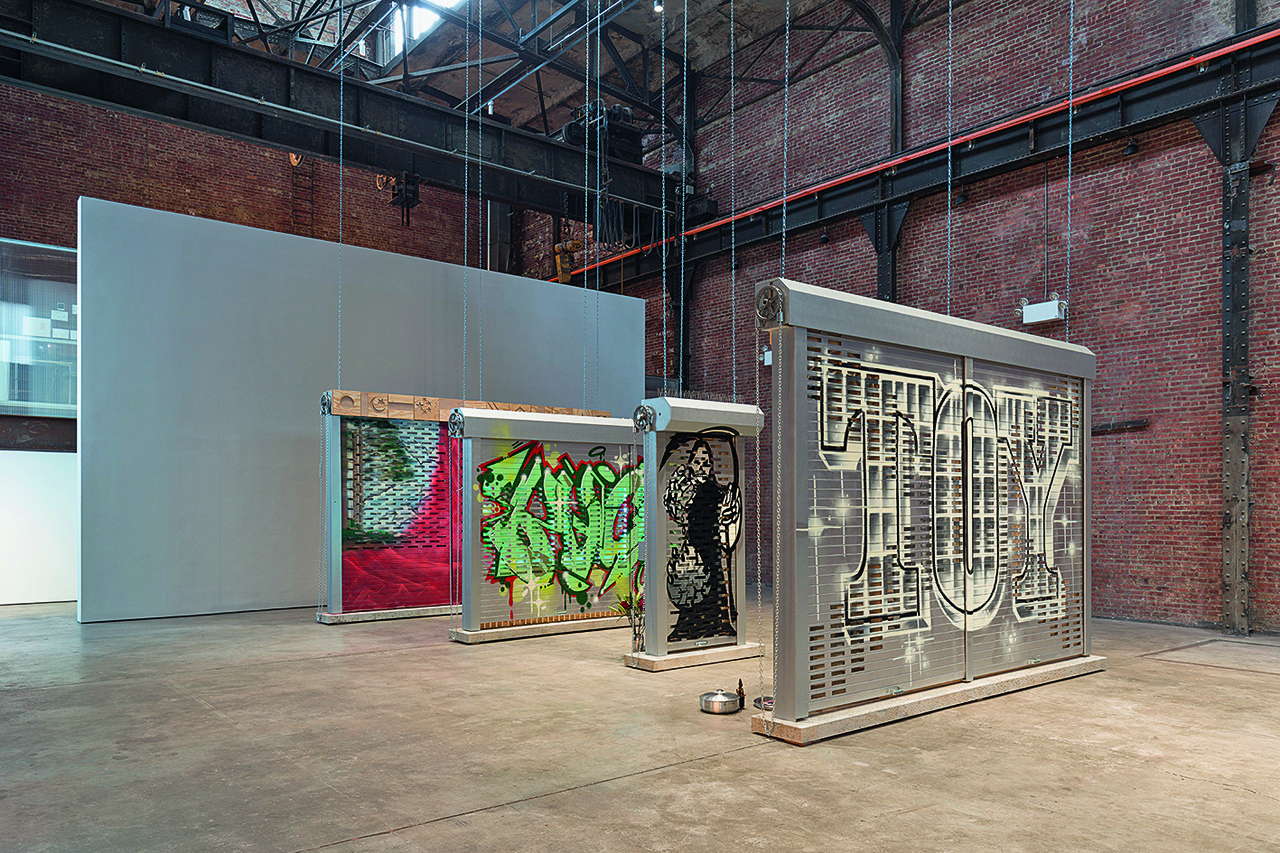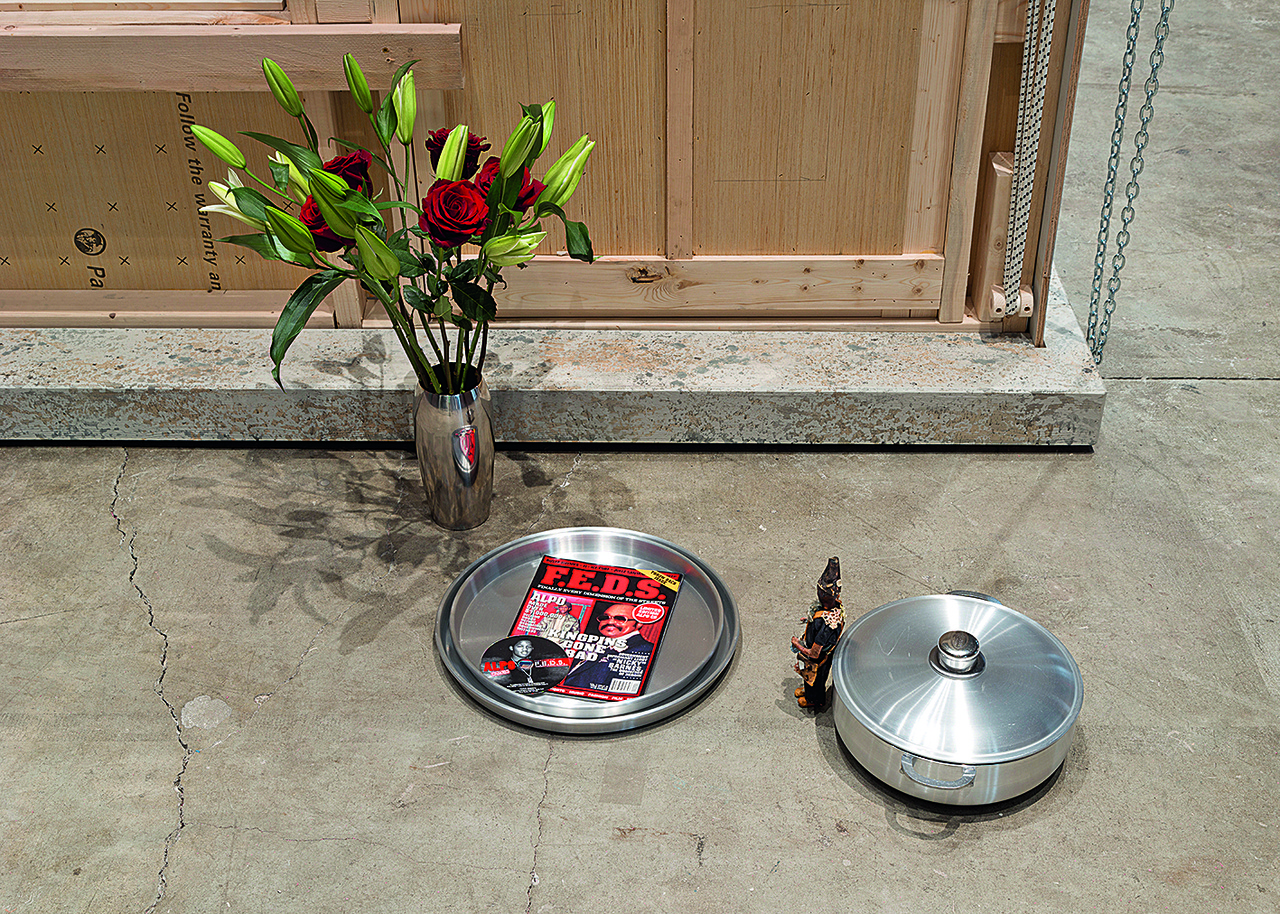“DRUG DEALER NEEDED – $5,000 A WEEK – EXCITING WORK” Adriana Blidaru on R.I.P. Germain at SculptureCenter, New York

“R.I.P. Germain: Avangarda,” SculptureCenter, New York, 2024
R.I.P. Germain’s work at SculptureCenter appropriates the language of urban architecture, immediately striking a chord of familiarity with the viewer. “Avangarda” is a sculptural installation made of four freestanding, life-size graffitied storefronts laced up with metal chains and positioned in succession in the main exhibition space. Aligned one after the other, they run parallel to one of the few white walls in SculptureCenter’s exhibition space. Germain’s installation engages in a playful dialogue with the architecture, highlighting a complex history of “front appropriation” or, as stated in the press release, “spaces that present themselves in one way but function in another.”
In a sense, SculptureCenter falls into this category. The nearly 100-year-old arts organization is currently housed in a building that was originally opened as a repair facility for locomotives in 1918. The original facade was kept as such, as were other elements (such as the signature red brick walls) that speak to the history of Long Island City as an industrial neighborhood. While nicely echoing the institution’s overarching context, Germain’s installation provides a framework to delve into a more specific form of “front appropriation,” referencing locales of illicit trade concealed behind the facades of everyday establishments like shops, bodegas, and cafés – a concept he and activist-curator Helen Starr term “baggy places.” [1] These spaces, governed by unwritten codes and informal regulations, can be traced back historically to urban communities that were left with little choice but to consolidate into tight social networks during times of economic injustice. The work blurs the boundaries between what is seen and what is hidden, raising the question of how these spaces have contributed to the resilience or survival of Black and Brown communities.
Germain loves a good riddle, though. As if scattering clues, he plays with appearances derived from stereotypes, encoding his work with layers that make for an engaging read, if one is willing to dig a little deeper. Take, for example, the object arrangements on the floor, positioned behind the storefronts: covered pots, small Black figurines, and trays containing miniature garments with big brand labels and fancy toy cars, as well as some underground independent magazines, alongside fresh flowers arranged in vases. These arrangements are a nod to Afro-Caribbean religions, such as Santeria, which normally involves offerings of food, fresh lilies, and trays with aspirational objects – an offering known as ebó – all to show reverence to the spirits.
A personal favorite among the offerings is the inclusion of independent magazines like Cocaine, High Times Encyclopedia of Recreational Drugs, and F.E.D.S. (aka Finally Every Dimension of the Streets). All these independent publications appeared in the ’90s, produced by and for street-culture insiders to chronicle their narratives. Despite circulating hand to hand, and primarily within Black and Brown communities, they enjoyed a large audience, most notably among inmates, an otherwise poorly documented demographic from a cultural point of view. For instance, issue 5 of F.E.D.S. – an all-women issue – featured a story titled “Santra Rucker Talks about Why she has 390 years in womens Federal Prison.” After eventually being banned in prisons for explicit depictions of crime and sex, F.E.D.S. experienced a surge in popularity that has been quite long-lasting (so much so that Vice News produced a documentary on the subject in 2016). [2]

R.I.P. Germain, “Silent Weapons For Quiet Wars (Build & Destroy),” 2024
Unpacking “Avangarda” at SculptureCenter by delving further into New York City’s historical context is important because “baggy spaces” exist within distinct backgrounds that are shaped by subcultures like the one described above. And while this history is mostly specific to New York, it is relevant to mention that this historical pattern resonates across major Western cities. By 1989, New York was experiencing one of the most severe crises of addiction, which was caused by the introduction of crack cocaine into local drug markets. Up until that point, extensive antidrug efforts such as Operation Pressure Point I and the Tactical Narcotics Teams (TNT) were implemented in the city to tackle street-level narcotics. In fiscal year 1989, New York City spent almost a billion dollars on drug-related enforcement of neighborhoods targeted by TNT for “buy and bust” operations. These neighborhoods were predominantly populated by underserved minority communities, for whom resources and opportunity had been limited by economic depression and Reagan-era red-tape policies. In the first 11 months of 1989, drug felony filings accounted for 32 percent of all felony arrests in New York City (with over 90,000 narcotics arrests from a total of 279,000), with statistics showing that 91.1 percent of those arrested were African American or Latino. However, incarceration became a revolving door: on the street, whoever was arrested was swiftly replaced. An attorney, reflecting on this 1980s reality, writes, “The publicized conviction of a drug dealer, by instantly creating a vacancy in the lucrative drug business, has the same effect as hanging up a help-wanted sign saying, ‘Drug dealer needed – $5,000 a week – exciting work.’” [3]
Under pressure, dealers seamlessly shifted their operations from the streets into more covert locations: in building lobbies, fortified apartments, or behind seemingly legitimate storefronts. Despite this maneuver, over the years, the majority of these properties were gentrified, and “baggy spaces” were gradually displaced from central neighborhoods like the Lower East Side, Bowery, and Tribeca. However, they continued to thrive in the more marginalized areas of the city. This resilience, reflected in Germain’s exploration of alternative systems, is evident through the flourishing of the independent publications presented in his installation. For instance, F.E.D.S. provided a wealth of DIY instructions for aspiring entrepreneurs: from buying cocaine, to consuming it, to transforming it into crack, along with the potential legal ramifications if caught. One FBI office supervisor says in an interview, “What alternative have I got for them [young dealers]? … I don’t like to admit it, but they’re pretty good capitalists.” [4]
Germain’s work initiates a discourse on how alternative systems and social dynamics emerge in response to structures of exclusion and how they, for better or worse, cater to the needs and aspirations of marginalized communities. There’s a conversation to be had about the resilience and ingenuity of marginalized actors – how they not only adapt to challenging circumstances but also outplay and dominate an already rigged system – as well as about ambition, materialism, and domination.
Taking a broader perspective, Germain’s installation reveals that forms of urban camouflage born in strategies of outmaneuvering became symbols of Black countercultural expression. Upon closer inspection of the works, one of the graffiti tags on the shutters reads “TOY” – a derogatory term for a novice. In this self-reflective gesture, Germain expands the interpretation of the work from a historical dimension to a contemporary one, prompting the question, How are counterculture aesthetics assimilated into mainstream discourse through the commerce of art?
This question leads us back to the late ’80s, when illegal storefront operations were beginning to disappear from Lower Manhattan under NYPD pressure, marking the onset of aggressive gentrification – particularly notable in the Lower East Side. Initially, squatters appeared, and community gardens emerged, tolerated and even institutionalized by the city to keep away the drug trafficking. Then, artists began occupying empty lofts, opening galleries and art spaces alongside existing working-class family housing. Subsequently, business owners established restaurants and shops, which drove up rents and displaced the neighborhood’s inhabitants, and eventually, corporate chains and developers took over almost entirely, displacing creatives, artists, and small businesses.
Through this process, elements of a neighborhood’s aesthetic are opened to dual interpretation. What was formerly symbolic of authenticity and countercultural expression is co-opted and leveraged into marketing tactics. Reclaimed bodegas became galleries, cocktail bars, or restaurants, and newcomers to the Lower East Side, in the ’80s, utilized these strategies as a means of signaling their belonging, unwittingly accelerating the gentrification process. Architect and urbanist Lara Belkind reflects on this evolution: “Value can now make an almost instantaneous jump from culture to commerce, and commerce has become a primary producer of culture.” [5]
Viewed through this lens, Germain’s installation “Avangarda” at SculptureCenter emerges as a symbolic monument to “baggy spaces.” The work guides us back to the origins of these spaces, which are rooted in the resilience and ingenuity of the communities that build them. Yet, it also confronts the stark truths of ambition, materialism, and dominance within these environments.
“Avangarda” further provides a commentary on the historical, social, and aesthetic evolution of “baggy spaces” as symbols of Black countercultural expression and their assimilation and appropriation into mainstream discourse. The inclusion of the graffiti reading “TOY” within the piece grounds this interpretation to the context of SculptureCenter, perhaps offering insight into the artist’s own reflective process and positioning within this intricate historical narrative.
“R.I.P. Germain: Avangarda,” SculptureCenter, New York, January 25–March 25, 2024.
Adriana Blidaru is a writer and curator based in New York. She runs the curatorial agency Living Content.
Images credit: Courtesy of R.I.P. Germain and Cabinet, London, photos Charles Benton
Notes
| [1] | “Baggy spaces” are quasi-lawless spaces that have distinct formal functions only accessible to those in the know. |
| [2] | “F.E.D.S.: Inside the Unofficial Newsletter of Urban Crime Culture,” Vice News, November 17, 2016, YouTube video, 9:17. |
| [3] | Michael Z. Letwin, “Report from the Front Line: The Bennett Plan, Street-Level Drug Enforcement in New York City and the Legalization Debate,” Hofstra Law Review 18, no. 3, article 9 (1990): 816. |
| [4] | Ibid., 815. |
| [5] | Lara Belkind, “Stealth Gentrification: Camouflage and Commerce on the Lower East Side,” Traditional Dwellings and Settlements Review (TDSR), 21, no. 1 (Fall 2009): 24. |

